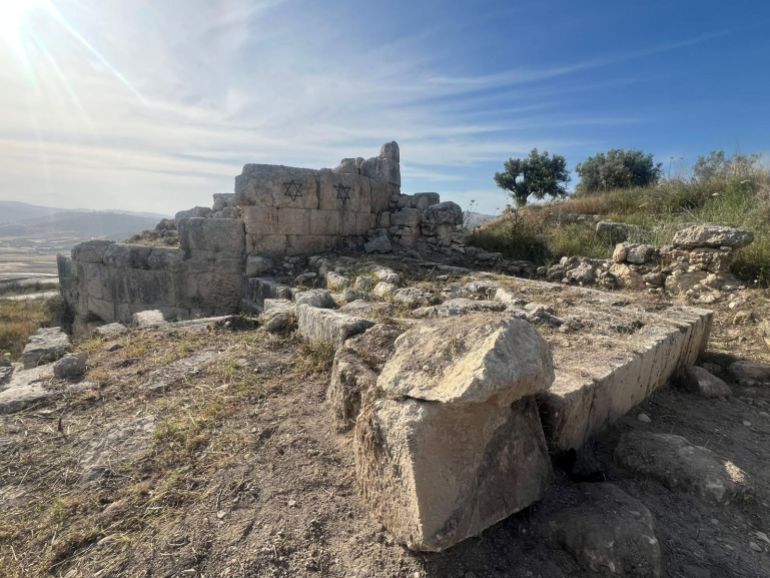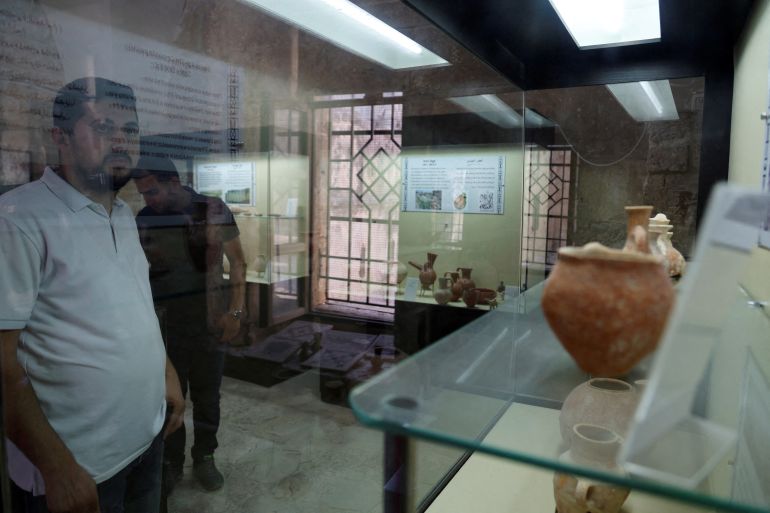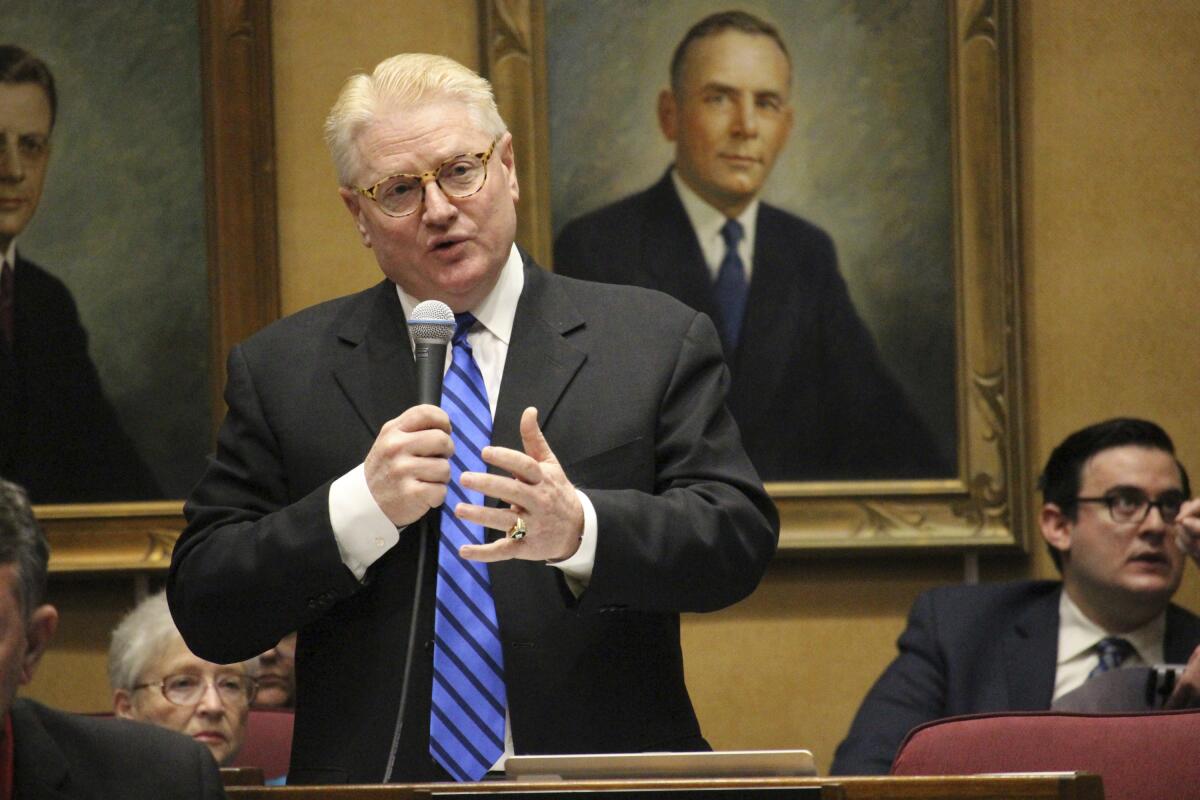SACRAMENTO — Few Californians have played a bigger role in turning the state Legislature to the right than two Orange County millionaires–conservative Christian Howard F. Ahmanson Jr. and his ally in politics, Senate Republican Leader Rob Hurtt.
Democrats denounce their millions in campaign donations. Advocates of campaign spending limits decry the sway their money has on elections.
But far more quietly, away from the headlines that large political contributions attract, the two millionaires have taken a parallel track, spreading their influence still further by spending millions on conservative think tanks and tax-exempt lobby groups that advance their goals.
Increasingly, these organizations incubate and shape Republican thought in Sacramento and frame public debate on issues from taxes and environmental law to gay rights, abortion, school vouchers and affirmative action.
Republican lawmakers, many of whom won office with help from Hurtt’s and Ahmanson’s money, often look to these groups for recommendations about positions to take, even what legislation to carry. Lawmakers tap the groups for staff and advisors, and, in revolving door fashion, the think tanks provide jobs for former legislative staffers and out-of-work politicians.
“They’re developing the ideas, and we’re trying to put bills through [the Legislature] based on those ideas,” Hurtt, of Garden Grove, said in an interview.
In the 1990s, Hurtt and Ahmanson have spent a combined $7.1 million on state campaigns, making them among the largest donors in state politics. Their money has helped elect 26 of 41 Assembly Republicans and seven of 16 Senate Republicans.
Unlike campaign spending, which by law must be publicly disclosed, there is no requirement that donations to private groups be reported. That’s why Ahmanson’s and Hurtt’s spending on policy institutes has gone largely unnoticed.
But since entering the political arena less than a decade ago, Ahmanson has spent more than $3.1 million and Hurtt at least $1.3 million on think tanks and conservative lobbying groups, interviews and tax records of the groups show.
“Hurtt’s money and Ahmanson’s play an agenda-setting role,” said author Sara Diamond, a Berkeley sociologist who writes extensively about conservative Christians. “This is really the genius of the New Right. You don’t wait for an election to come around. A better way to influence policy is to finance think tanks. They create interest and a demand” in issues.
*
Some think tanks that receive money from Ahmanson and, to a lesser extent, Hurtt, have a libertarian bent and advocate free-market prescriptions for society’s ills. Others are Bible-based and battle for “traditional family values.” For the most part, they produce writings light on statistical proof and heavy on opinion, which makes some people question the legitimacy of their credentials as researchers.
“Many of these organizations are adversarial in nature, explicitly so,” said Jess Cook of the research-oriented Rand Corp. of Santa Monica, which receives no money from Ahmanson or Hurtt. “That’s the growth sector in the think tank industry in recent years. They’re not doing fact-based research. They’re advocating a certain point of view.”
One of the biggest beneficiaries of Hurtt’s and Ahmanson’s largess is the Christian-based Capitol Resource Institute, which they founded in 1987 to organize abortion foes in Sacramento. Some of its newest goals: pushing a measure to deny recognition of same-sex marriage and junking the state’s no-fault divorce law, making it harder to dissolve a marriage.
These policy institutes try to be at the fore of the hottest issues in state politics–attacking welfare, affirmative action, public schools, public employee unions, taxes, environmental law. Opposition to abortion and gay rights are recurrent themes.
“I would not propose we have policemen battering down people’s doors to see what they’re doing in the bedroom,” said Larry Arnn, president of the Claremont Institute, which received $185,000 from Ahmanson last year and lesser sums from Hurtt. “But I wouldn’t have [gay] rights recognized, because I don’t think they are rights. They fit into a different class than protections for blacks and women. We think it’s wrong. It’s a violation of natural law.”
The groups funded by Hurtt and Ahmanson are nonprofit and exempt from income taxes. In exchange for tax breaks, they must limit their lobbying. But through their position papers, guest columns in newspapers, radio broadcasts and newsletters, their reach extends from the grass-roots to the governor’s office.
“We have to make the constituency aware of what’s going on on a timely basis. The key there is timely,” Hurtt said. “It’s a total education. If people want to get involved, they let them know, ‘Here’s how you can do it.’ ”
One of the Legislature’s biggest boosters of think tanks is state Sen. Ray Haynes (R-Riverside). A leading abortion opponent, Haynes won an Assembly seat in 1992 and a Senate seat in 1994 with $512,000 from Hurtt and a political action committee Hurtt and Ahmanson helped found. As a legislator, Haynes has carried bills sponsored by think tanks, and hired an aide from Capitol Resource.
“You know what your principles are. You know which way you want to go. But sometimes you get lost. These think tanks keep your compass straight,” Haynes said.
Haynes sits on the board of directors of the American Legislative Exchange Council. Funded by conservative foundations, pro-gun groups and corporations, including pharmaceutical manufacturers and tobacco companies, the council distributes volumes of “model” legislation to lawmakers around the country.
In California last year, legislators introduced 40 of the group’s bills. Topics ranged from limits on gun control and litigation to restrictions on unions, welfare and obscenity. Some bills cleared the Assembly, where the GOP has a majority. One, a bill to increase prison terms, cleared the Democrat-controlled Senate and was signed into law.
When he became active in the council, Haynes concluded that its education and welfare proposals were outdated. So earlier this year, he asked Ahmanson to fund research in the areas. Ahmanson responded by giving the group $80,000.
Hurtt, Ahmanson and Ahmanson’s wife, Roberta Green Ahmanson, have said in past public statements that their political involvement is driven by their moral concerns. Ahmanson is a Calvinist, following the teachings and stern moral code of the 16th Century theologian John Calvin. He funds his philanthropy from the fortune left him by his father, Howard F. Ahmanson Sr., founder of Home Savings & Loan. Hurtt, an evangelical Christian, has accumulated his wealth since taking over his family’s Garden Grove manufacturing plant, Container Supply Co.
The Ahmansons refused to be interviewed about their political activities. But they did write to The Times to say their political involvement constitutes a “very small part of the total that we do, and it exists only to protect our private charitable efforts.”
The Ahmansons fund many nonpolitical causes, from a USC professor’s research into oppression of Armenians to international efforts to protect Christians from religious persecution. Ahmanson has given the Orange County Rescue Mission more than $1 million.
“Our primary motive is to serve God by doing what we can to make life better for as many as we can,” the Ahmansons wrote.
*
Assembly Speaker Curt Pringle (R-Garden Grove) contends that when Democrats controlled the Assembly, lower-house staff researchers amounted to a Democratic think tank. As a result, Pringle says, conservatives turned to outside groups for policy ideas.
Since becoming speaker in January, Pringle has tapped three groups that receive Ahmanson’s money–Reason Foundation of Santa Monica, Pacific Research Institute of San Francisco and Claremont Institute–for appointees to state advisory commissions on transportation, education and the California Constitution.
Claremont is among the most influential California think tanks. Its staff includes former television commentator Bruce Herschensohn, hired after his failed run for U.S. Senate in 1992. Its major donors include Los Angeles industrialist Henry Salvatori, who was part of President Reagan’s kitchen cabinet, conservative foundations and corporations such as Philip Morris and Union Petroleum.
Ahmanson became one of the largest donors to Claremont in the 1990s, giving $721,000. He and his wife are on Claremont’s board, along with others, including Orange County GOP Chairman Thomas A. Fuentes; Tom Silver, chief of staff to Los Angeles County Supervisor Mike Antonovich; and television personality Pat Sajak.
Ahmanson’s money helps pay for Claremont’s Sacramento office. Located across from the Capitol, Claremont’s Golden State Center’s staff includes former Assembly Republican Tom McClintock. He joined Claremont after he lost his 1994 run for controller; he currently is running for a San Fernando Valley Assembly seat, and has received campaign money from Ahmanson’s political action committee.
McClintock envisions Claremont one day having as much influence in Sacramento as the Heritage Foundation has in Washington. It’s already a player. Republican lawmakers cite McClintock’s papers calling for dramatic cuts in the state budget. Claremont helped organize parts of Gov. Pete Wilson’s recent conference on welfare and the importance of fathers.
In his first appointments after becoming speaker, Pringle named Claremont’s Arnn and a second Claremont fellow to the California Constitutional Revision Commission, which is drafting changes to the state Constitution.
In making the appointment, Pringle cited Arnn’s academic background, which includes a focus on the founding principles of the United States. Arnn also makes forays into politics. With funding from Ahmanson, Hurtt and their allies, Arnn ran for Congress in 1992, but lost the primary to Rep. Ken Calvert (R-Riverside). Currently, Arnn is a co-chairman of the November initiative to end affirmative action in government.
Through position papers and books, Claremont advocates applying the nation’s founding principles to current problems. Claremont papers conclude the state would be better off with free-market economics, fewer government restrictions on business and lower taxes. Its tracts also oppose gay rights, pornography and abortion.
Hurtt, who gives Claremont $1,000 a month and hired a Claremont researcher to be one of his state budget analysts, predicts that if the GOP gains control of the Senate, as it has in the Assembly, Claremont’s many writings “will give us the ammo” for legislation.
While corporations fund free-market think tanks, they rarely give to Bible-based groups. Not so Hurtt and Ahmanson. They have helped several Christian groups. One is Capitol Resource Institute. Ahmanson has given $490,000, though he no longer is a donor. Hurtt has given the group $920,000 and hired his chief of staff and press secretary from the group.
These days, some Capitol Resource projects are about as controversial as apple pie, such as 30-second public service television spots airing statewide that champion the role of fathers. But it also is behind one of the most emotional bills of the year, a measure to deny recognition of same-sex marriages sanctioned by other states.
Capitol Resource Director Michael Bowman, a former aide to Sen. Haynes, said he believes gay advocates’ efforts to win approval of same-sex marriage is “a way for homosexuals to attack the church.”
Next year, the group hopes to start what Bowman calls “a cultural debate on divorce” by sponsoring legislation to make divorce harder to obtain and ending the “no-fault” divorce system.
*
On his own, Ahmanson is the major financial backer of one of the Christian right’s most controversial theologians, Rousas John Rushdoony, giving Rushdoony’s think tank, Chalcedon, $733,000 in the past decade.
Rushdoony is an 80-year-old Calvinist who has a small parish and Christian school outside Angel’s Camp in the Sierra foothills. For several years, Ahmanson was a trustee of Chalcedon. From 1975 to 1983, Ahmanson frequently visited Rushdoony and leased a home nearby, Rushdoony said.
“He was essentially relying on me [spiritually],” Rushdoony said.
A prolific author, Rushdoony contends Christianity should apply to all aspects of life and that government’s role should be minor. Individuals, charities and churches should take over most–if not all–responsibility for welfare, for example, and Rushdoony long has been a proponent of home- and church-schooling.
Rushdoony is a soft-spoken man whose living room is filled with stacks of religious, political and popular books. Many of his views seem extreme.
In Rushdoony’s magnum opus, “The Institutes of Biblical Law,” he contends the Holocaust death toll of 6 million Jews is vastly inflated and that experts who cite that figure commit the biblical sin of bearing false witness.
“The evils [of the Nazis] were all too real: Even greater is the evil of bearing false witness concerning them, because that false witness will produce an even more vicious reality in the next upheaval,” Rushdoony writes. The Anti-Defamation League called Rushdoony’s comments “a striking addition to the canons of Nazi apology.”
In his tome, Rushdoony also contends that God, through the Bible, authorizes the death penalty for 18 sins. On the list is murder, rape of a betrothed virgin, adultery, promiscuity by unwed women, homosexuality, sodomy, striking or cursing a parent, habitual criminality, blasphemy and bearing false witness.
“The hostility to the death penalty is humanism’s hostility to God’s law,” Rushdoony writes. “But God’s government prevails, and His alternatives are clear-cut: either men and nations obey His laws, or God invokes the death penalty against them.”
Rushdoony says he does not seek to impose biblical law, at least not until the majority of people adhere to biblical law. Rather, he is a commentator on what the Bible requires, and a “Christian libertarian.”
“It’s my duty to set forth God’s requirements,” Rushdoony said. “Then each man is going to bear the responsibility for the stand he takes.”
Rushdoony has gotten involved in secular pursuits, helping, for example, political consultant Wayne Johnson get his start in the early 1980s by recommending that a friend, then-state Sen. H.L. Richardson (R-Arcadia), hire Johnson. Johnson, a Chalcedon trustee, has run campaigns for several Republicans in Congress and the Legislature, including ones funded by Ahmanson and Hurtt.
Despite his profession, Johnson, like Rushdoony, has little faith that politicians can change society. Rather, he seeks to assist candidates who “won’t padlock the churches.” Said Johnson: “The state should get out of the way and let the church do its work.”
(BEGIN TEXT OF INFOBOX / INFOGRAPHIC)
Influence and the Issues
Since 1987, Howard F. Ahmanson Jr. has contributed at least $3.1 million to various conservative think tanks and tax-exempt lobby groups. Senate Republican Leader Rob Hurtt of Garden Grove has given $1.3 million. Here are some of the groups:
FREE MARKET ADVOCATES
* Reason Foundation, Santa Monica, and Pacific Research Institute, San Francisco: Ahmanson agrees with these groups that public schools are failing. He donated $400,000 to promote passage of the 1993 school voucher initiative and was attracted to these groups because they advocate tax-funded vouchers for private school tuition. Most recently, Ahmanson gave $97,000 to the Reason Foundation to fund reports that were critical of teachers unions and that contended private schools can do a better job of educating children with physical and emotional problems. Gov. Pete Wilson has used the groups’ research for his proposals to turn some government functions over to private enterprise. He and Assembly Speaker Curt Pringle (R-Garden Grove) have appointed researchers from both groups to advisory commissions. Ahmanson has donated $138,000 to Reason and $30,000 to Pacific Research.
BIBLE-BASED GROUPS
* Focus on the Family, Colorado Springs, Colo.: A leader in the traditional family values movement. Hurtt says Focus’ founder, psychologist James C. Dobson, inspired him to get involved in politics. In the late 1980s, Ahmanson gave Focus $279,212 and Hurtt gave $250,305. Hurtt says he continues to give.
* Capitol Resource Institute, Sacramento: One of 32 “family policy councils” affiliated with Focus on the Family; founded by Hurtt and Ahmanson in 1987 as a gathering place for antiabortion forces. Ahmanson has donated $490,000, though he no longer contributes. Hurtt, who has given more than $920,000, says he is scaling back contributions to $5,500 per month.
* Traditional Values Coalition, Anaheim: Run by the Rev. Louis P. Sheldon, a vocal opponent of abortion, gay rights and other issues in Sacramento and Washington. Hurtt and Ahmanson each started giving $10,000 to $20,000 per year in the mid-1980s. In 1990 and 1992, Ahmanson gave $35,000 to help mail voter guides to 8,000 churches statewide. But Hurtt and Ahmanson have not donated in recent years. Sheldon’s mailing list stands at roughly 100,000 potential donors and raises money with regular appeals.
THE LAW
* Western Center for Law and Religious Freedom, Sacramento: Formerly based in Capitol Resource Institute office; provided legal defense for Operation Rescue’s antiabortion protesters. Ahmanson gave $56,500. Hurtt gave $10,000 to fund a suit by former Los Angeles Assistant Police Chief Robert Vernon, who said he was a victim of discrimination by the city of Los Angeles because of his Christian beliefs. Founder David Llewellyn, dean of Simon Greenleaf School of Law in Anaheim, describes Ahmanson as a “substantial” donor. School’s brochure describes its goal as “building a new generation of Christian lawyers.”
NATIONAL GROUPS
* Free Congress Foundation, Virginia: To compete with liberal think tanks in Washington, conservative strategist Paul Weyrich in the 1970s helped found Heritage Foundation–one of the most influential think tanks in Washington–American Legislative Exchange Council, and the Free Congress Foundation, which he still operates. Ahmanson gives about $30,000 a year to Free Congress for Weyrich’s National Empowerment Television, a cable network offering conservative and religious perspectives on current events. “No one could possibly understand my politics without understanding my spiritual point of view,” Weyrich said. “Separation of church and state is artificial.”
* National Coalition for the Protection of Children & Families, Cincinnati: Formerly known as the National Coalition Against Pornography, the group battles obscenity and child pornography, and helps lobby against adult businesses. It has received substantial funding from Focus on the Family. Ahmanson’s wife, Roberta Green Ahmanson, served on its board. Ahmanson has given $1.2 million; Hurtt, $22,500.
Sources: Tax records of the various groups, Times reports; researched by DAN MORAIN/Los Angeles Times








![Handout photograph taken and released by the press service of Ukrainian army during a training exercise at an undisclosed location near the front line in the Zaporizhzhia region [File: Andriy Andriyenko /Ukrainian Armed Forces/ AFP]](https://www.occasionaldigest.com/wp-content/uploads/2025/05/000_488G9G3-1748346027.jpg)












